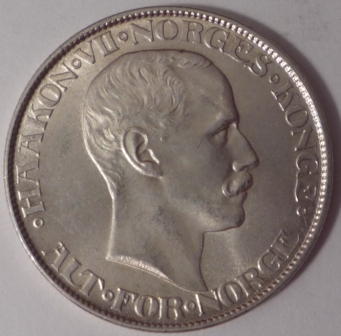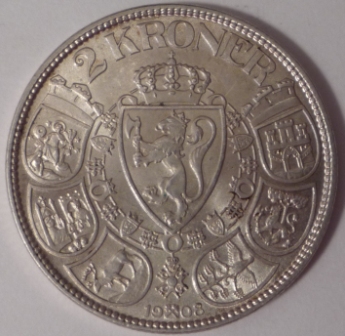Hier die absolute Lieblingsmünze meines zweiten Sammelgebietes. Nach der Unabhängigkeit von Schweden 1905 und der Wahl Prinz Carls von Dänemark zum König von Norwegen ( Edward VII war sein Schwiegervater, das war zu dem Zeitpunkt seine grösste Qualität ), gab man sich in Kongsberg viel Mühe, eine Münzserie zu entwerfen, die der Selbständigkeit der alten- jungen Nation auch auf numismatischem Gebiete Rechnung tragen sollte. Nachdem 1906 und 1907 Bronzemünzen im Stil der unter Oscar II geprägten Münzen geprägt wurden, kam es ab 1908 zur Ausgabe der neuen Kursmünzenserie in den Werten 1,2,5, 10, 25 und 50 Øre, sowie 1 und 2 Kronen. 1910 folgten Goldmünzen zu 10 und 20 Kronen.
Die Münzen, die vom Hauptgraveur der Münze in Kongsberg, Ivar Throndsen, entworfen wurden, vereinen in ihrer Gestaltung Elemente des Jugensstils und Details der Münzen des norwegischen Mittelalters. Der Bezug auf das Mittelalter war wichtig, da so unterstrichen wurde, dass Norwegen eine christliche Nation war.
Auf den Kleinmünzen findet sich das Dreieinigkeitszeichen das auf zahleichen Pfennigen des 10. und 11. Jahrhunderts zu sehen war, auf den Goldmünzen ist der auf dem Drachen stehende St. Olav wiedergegeben, der so auf Schillingstücken des Trondheimer Erzbischofs Erik Valkendorf( 1510 - 22 ) abgebildet ist.
Der Wappenlöwe, der in einen spitz zulaufenden Schild gestellt ist, entstammt dem Pfennig von Eirik Magnusson ( 1280 - 99 ) und lehnt sich damit an die erste bekannte Darstellung des norwegischen Wappens an.
Auf dem Zweikronenstück ist der Wappenlöwe umgeben von den Wappen der ( damals ) sechs Bischofssitze. Von links nach rechts : Kristiania, Trondhjem, Tromsø, Hamar, Kristiansand, Bergen.
Das Zweikronenstück wurde in dieser Form nur 1908 in einer Auflage von 200.000 Stück geprägt, 1909 wurde das Königsportrait überarbeitet, da es mit seiner Höhe eine Massenproduktion erschwerte. Mit flacherem Relief wurde von 1910 bis 1917 jeweils 150.000 bis 375.000 Ex geprägt, dann bereitete der Zerfall der skandinavischen Münzunion der Grossilberausmünzung ein Ende. Aus dem Jahr 1909 sind ca 20 als Proben anerkannte Exemplare mit flachem Relief bekannt, zuletzt wurde im vergangenen Herbst eine solche Probe für ca 20.000 Euro versteigert, die Preise für die herkömmlichen Exemplare sind zum Glück humaner.
Dateianhang:
 2 Kr N 1908 Av.JPG [ 93.25 KiB | 16965-mal betrachtet ]
2 Kr N 1908 Av.JPG [ 93.25 KiB | 16965-mal betrachtet ]
Dateianhang:
 2 Kr N 1908 Re.JPG [ 101.22 KiB | 16965-mal betrachtet ]
2 Kr N 1908 Re.JPG [ 101.22 KiB | 16965-mal betrachtet ]